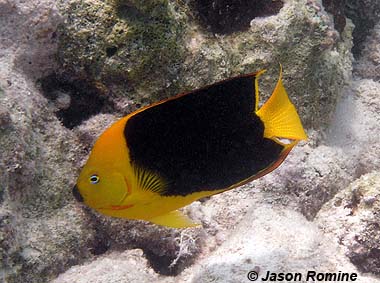
Holacanthus tricolor
This easily recognizable reef fish is territorial, rarely leaving the small radius around its home area, and develops a long-term monogamous breeding relationship. It has a flat, oval black body with trailing black dorsal and anal fins (with yellow and orange margins), a yellow tail, and a yellow face with a black mouth. The juvenile is almost completely yellow, with a black spot on either side that grows slowly to cover most of its body. These angelfish are collected for the aquarium trade even though they are difficult to maintain.
Order – Perciformes
Family – Pomacanthidae
Genus – Holacanthus
Species – tricolor
Common Names
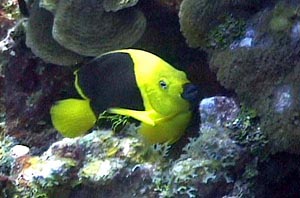
Rock beauty, corn sugar, coshubba, rock beasty, and yellow nanny are common English language names used to refer to Holacanthus tricolor. Other common names include demoiselle beaute (French), felsschönheit (German), isabelita medioluto (Spanish), nefrytek tróbarwny a. ustnik skalny (Polish), nuriwake-yakko (Japanese), soldado (Portuguese), and vaqueta de dos colores (Spanish).
Importance to Humans
The rock beauty is not a numerous species, although it may seem that way due to their high visibility on the reef. Their flesh is non-poisonous, but they are generally not harvested for food. Perhaps this is because their intrinsic value as aesthetically beautiful fish on the reef. They are harvested for the aquarium trade, even though their specific diets and territoriality make them a difficult species to keep.
Conservation
> Check the status of the rock beauty at the IUCN website.
The IUCN is a global union of states, governmental agencies, and non-governmental organizations in a partnership that assesses the conservation status of species.
Geographical Distribution
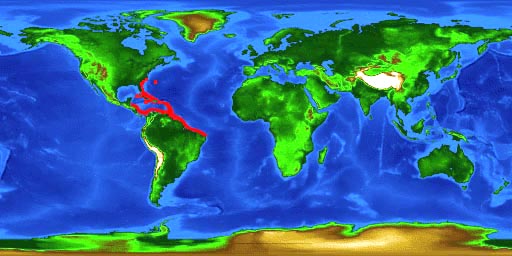
The rock beauty is a species associated with clear, shallow reef habitats of the tropical western Atlantic Ocean. It is found from Georgia to Bermuda and the Bahamas, and from Florida to southeastern Brazil.
Biology
Distinctive Features
Body of the rock beauty is thin and discus-shaped. The mouth is small with comb-like teeth. The dorsal fins are scaled and not divided into two sections as in the closely related spadefish (Chaetodipterus). The lobes of the dorsal and anal fins become produced into long filaments as the fish ages. Identification of the rock beauty is based upon the distinctive coloration rather than body morphology.
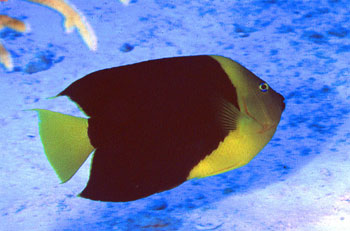
Coloration
The rock beauty is easily distinguished from other members of the family by its distinctive black and yellow coloration. The head and tail are bright yellow, and this yellow creates a border around the black body. The lips, eyes, and margins of the dorsal and anal fins are an iridescent blue and the caudal fin is entirely yellow. Front edge of the anal fin and edge of gill cover are orange. The upper and lower part of the iris is bright blue. Lips are black. The juveniles share the same colors of the adults but not the same pattern. The juvenile is entirely bright yellow except for a small blue-ringed black spot under the dorsal fin. As the juvenile grows, the black spot increases in size and spreads throughout the body, much like the way ink spreads across paper. The blue ring eventually disappears as the fish matures.
Size
The rocky beauty is the smallest angelfish in the Atlantic, reaching a maximum length of approximately 12 inches (35 cm).
Dentition
They have small, protractile mouths that contain brush-like bands of comb-like teeth.
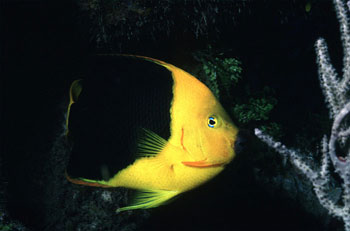
Food Habits
Their diet consists of mainly sponges but they have been known to occasionally snack on corals, tunicates, and algae.
Reproduction
Adults generally form long lasting, perhaps even monogamous, pairs. Often these pairs consist of a large and a small individual, perhaps suggesting a sexual dimorphism that may exist in this species. There is, however, no difference in the coloration of the sexes. The pair mates by rising slowly up in the water column, bringing the bellies close together, and releasing large amounts of sperm and eggs into the water. The female can release anywhere from 25 to 75 thousand eggs each evening, and as many as ten million eggs during each spawning cycle. The eggs are transparent, spherical, and pelagic, each containing a single droplet of oil to provide buoyancy. The eggs hatch in 15 to 20 hours after fertilization. The young enter a sort of pre-larval stage, where they lack functional eyes, fins, and a gut. The larvae are still attached to a large yolk sac. The yolk is absorbed in two days, during which time the young become fully functional and free swimming larvae. Growth is rapid and three to four weeks after hatching, the juvenile rock beauty settles on the reef. The juveniles are very territorial but, unlike other angelfish, they do not set up cleaning stations. They are thought to feed on planktonic animals, small invertebrates, and even mucus secreted from other fish.
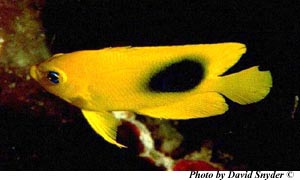
Predators
Large carnivorous fish, including snappers, are known to feed on the rock beauty.
Taxonomy
Originally described as Chaetodon tricolor by Bloch in 1795, it was later renamed Holacanthus tricolor (Bloch, 1795). There are no known synonyms used to refer to this fish.
Prepared by: Casey Patton